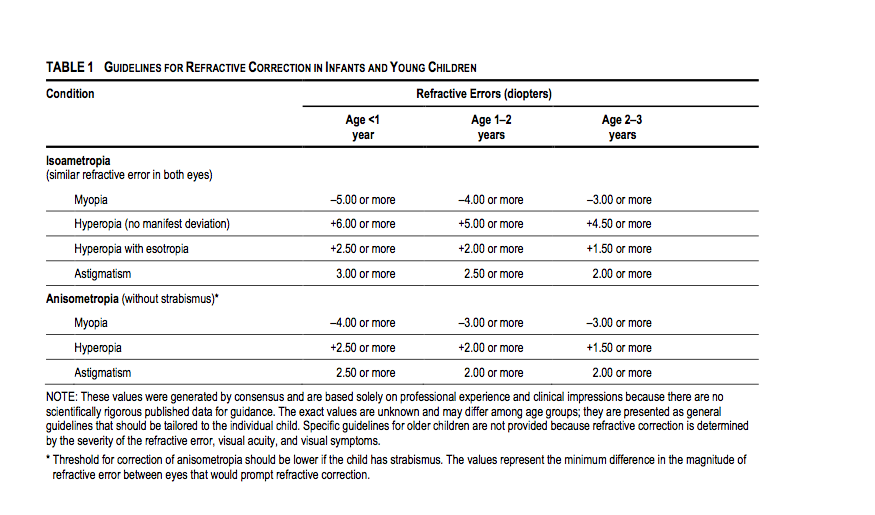OCT 21, 2015
Amblyopia
Refractive Amblyopia
Uncorrected refractive errors are considered the most common cause of amblyopia. There are two main types of refractive amblyopia. Anisometropic amblyopia refers to unilateral amblyopia caused by a distinct refractive error of each eye. Isoametropic amblyopia occurs when both eyes are amblyopic from a significant yet similar refractive error. Severity of the refractive error and the amblyopia are directly related. Anisometropic amblyopia is likely in the presence of 1.0–1.5 D or more anisohyperopia, 2.0 D or more anisoastigmatism, and 3.0–4.0 D or more anisomyopia. Bilateral or isoametropic amblyopia may occur in the presence of 5.0–6.0 D or more of myopia, 4.0–5.0 D or more of hyperopia or 2.0–3.0 D or more of astigmatism. Amblyopia caused by significant astigmatism is referred to as meridional amblyopia.1-2
The Academy has published treatment guidelines for refractive correction in infants and young children (Table 1). Treatment of refractive amblyopia may require only spectacle correction.

Strabismic Amblyopia
Strabismic amblyopia results from suppression of the deviating eye. Constant strabismus leads to more severe amblyopia than intermittent strabismus. The optimal timing of strabismus surgery in individuals with strabismic amblyopia remains unknown.3
Deprivation Amblyopia
Deprivation amblyopia is the least common and typically most severe form of amblyopia and develops when the visual axis is obstructed. Various causes of stimulus deprivation include eyelid ptosis, cornea opacities, cataracts, vitreous hemorrhage among others.
Reverse Amblyopia
Reverse amblyopia is a result of penalizaton of the sound eye with patching or atropine during amblyopia treatment of the original amblyopic eye. The type of amblyopia and its severity not only adversely affect visual acuity but also binocularity, contrast sensitivity, grating acuity, and central versus eccentric fixation.
Related Resource
AAO Preferred Practice Patterns Amblyopia 2012
References
- BCSC Pediatric Ophthalmology and Strabismus. Section 6. 2014-15.
- In DynaMed [database online]. EBSCO Information Services. http://www.dynamed.com/login.aspx?direct=true&site=DynaMed&id=113862. Updated April 25, 2015. Accessed May 17, 2015.
- Korah S, Philip S, Jasper S, Antonio-Santos A, Braganza A. Strabismus surgery before versus after completion of amblyopia therapy in children. Cochrane Database Syst Rev. 2014 Oct 15;10:CD009272.